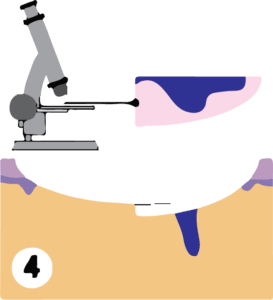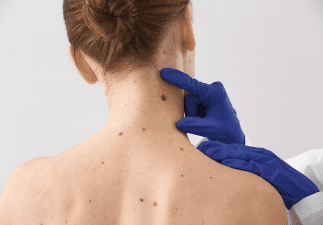During Mohs surgery, the procedure is conducted in sequential stages, all completed within a single visit, with intervals for examination and waiting in between. The surgeon begins by removing a layer of tissue, which is then examined under a microscope in a nearby laboratory. If any cancer cells are detected, the surgeon precisely removes another layer of tissue from the identified location, aiming to preserve as much healthy tissue as possible. This process continues until no cancer cells remain.
Step 1: Examination and Preparation

Depending on the location of the skin cancer, the patient may wear street clothes or a hospital gown. The Mohs surgeon assesses the biopsy site, possibly marking it for reference, and positions the patient accordingly. Local anesthesia is administered to ensure complete numbing of the area, allowing the patient to remain awake throughout the procedure.
Step 2: Removal of Top Layer

Using a scalpel, the surgeon removes a thin layer of visible cancerous tissue. However, since some skin cancers may have deeper roots, further analysis is necessary to ascertain their extent. The wound is temporarily bandaged, giving the patient time to relax while laboratory analysis takes place.
Step 3: Laboratory Analysis
The excised tissue is sectioned, color-coded, and mapped for reference. In the laboratory, thin horizontal slices are made, stained, and examined under a microscope, a meticulous process that requires time.
Step 4: Microscopic Examination

The surgeon meticulously examines the tissue on microscope slides, marking any remaining cancer cells on the map. Depending on the findings, additional tissue removal may be necessary.
Step 5: Removal of Subsequent Layers

If further tissue removal is required, the surgeon administers more anesthesia and precisely excises the identified areas of cancerous cells. Meanwhile, laboratory analysis recommences. This iterative process continues until all cancer cells are eliminated.
Step 6: Wound Repair
Once the site is clear of cancer cells, the wound may be left to heal naturally or closed with stitches, depending on its size and location. In some cases, complex wounds may require reconstruction using adjacent tissue or a skin graft, sometimes involving coordination with other specialists.
Step 7: Conclusion
The duration of the entire process may vary, potentially lasting several hours. Despite its duration, Mohs surgery offers high cure rates and minimizes scarring by preserving healthy tissue. Adhering to post-operative care instructions is crucial for optimal outcomes.




